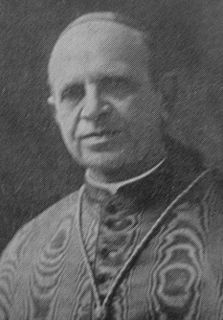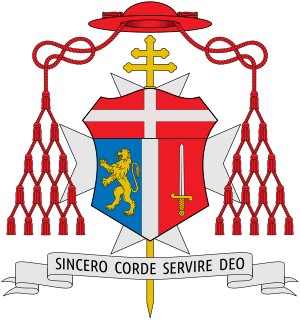
Pietro Gasparri, GCTE was a Roman Catholic cardinal, diplomat and politician in the Roman Curia and the signatory of the Lateran Pacts. He served also as Cardinal Secretary of State under Popes Benedict XV and Pope Pius XI.
The Congregation for the Oriental Churches is a dicastery of the Roman Curia, and the curial congregation responsible for contact with the Eastern Catholic Churches for the sake of assisting their development and protecting their rights. It also maintains whole and entire in the one Catholic Church, alongside the liturgical, disciplinary, and spiritual patrimony of the Latin Rite, the heritage and Oriental canon law of the various Eastern Catholic traditions. It has exclusive authority over the following regions: Egypt and the Sinai Peninsula, Eritrea and northern Ethiopia, southern Albania and Bulgaria, Cyprus, Greece, Iran, Iraq, Lebanon, Palestine, Syria, Jordan and Turkey, and also oversees jurisdictions based in Romania, Southern Italy, Hungary, India and Ukraine. It was founded by the Motu Proprio Dei Providentis of Pope Benedict XV as the "Sacred Congregation for the Oriental Church" on 1 May 1917 and "considers those matters, whether concerning persons or things, affecting the Catholic Oriental Churches."

Willem Marinus van Rossum, C.Ss.R. was a Dutch prelate of the Roman Catholic Church. He was made a cardinal in 1911, led the Apostolic Penitentiary from 1915 to 1918, and served as Prefect of the Congregation for the Propagation of the Faith from 1918 until his death.
Acta Apostolicae Sedis, often cited as AAS, is the official gazette of the Holy See, appearing about twelve times a year. It was established by Pope Pius X on 29 September 1908 with the decree Promulgandi Pontificias Constitutiones, and publication began in January 1909. It contains all the principal decrees, encyclical letters, decisions of Roman congregations, and notices of ecclesiastical appointments. The laws contained in it are to be considered promulgated when published, and effective three months from date of issue, unless a shorter or longer time is specified in the law.
The Code of Canons of the Eastern Churches is the title of the 1990 codification of the common portions of the Canon Law for the 23 Eastern Catholic churches in the Catholic Church. It is divided into 30 titles and has a total of 1546 canons. The western Latin Church is governed by its own particular code of canons, the 1983 Codex Iuris Canonici.

The Pontifical Oriental Institute (Orientale), is a Catholic institution of higher education located in Rome. The plan of creating a school of higher learning for Eastern Christianity had been on the agenda of the Catholic Church since at least Pope Leo XIII, but it was only realized in 1917 by Pope Benedict XV (1914-1921). The Orientale forms part of the consortium of the Pontifical Gregorian University and the Pontifical Biblical Institute, both in Rome. All three institutions are run by the Society of Jesus (Jesuits). While the Orientale depends on the Holy See, its management is entrusted to the Society of Jesus. Its Chancellor is the Prefect of the Congregation for the Eastern Churches and its Vice-chancellor is the Superior General of the Society of Jesus, while the Congregation for Catholic Education is the dicastery competent for approving the academic programmes of the Orientale.
The Declaration on Masonic Associations is a declaration by the Congregation for the Doctrine of the Faith re-iterating the prohibition of Catholics from joining Masonic organizations. Its Latin title is Declaratio de associationibus massonicis. The document states that Catholics who join Masonic organizations are in a state of grave sin and may not receive Holy Communion. It was issued in 1983 by the prefect of the congregation, Joseph Cardinal Ratzinger, who became Pope Benedict XVI on April 19, 2005.
The canon law of the Catholic Church is the system of laws and legal principles made and enforced by the hierarchical authorities of the Catholic Church to regulate its external organization and government and to order and direct the activities of Catholics toward the mission of the Church. It was the first modern Western legal system and is the oldest continuously functioning legal system in the West, while the unique traditions of Oriental canon law govern the 23 Eastern Catholic particular churches sui iuris.
The Pontifical Council for Legislative Texts is a dicastery of the Roman Curia. Its work "consists mainly in interpreting the laws of the Church".. It is distinct from the highest tribunal or court in the Church, which is the Supreme Tribunal of the Apostolic Signatura, and does not have law-making authority to the degree the Pope and the Holy See's tribunals do. Its charge is the interpretation of existing canon laws, and it works closely with the Signatura and the other Tribunals and the Pope. Like the Signatura and the other two final appellate Tribunals, the Roman Rota and the Apostolic Penitentiary, it is led by a prefect who is a bishop or archbishop.

Enrico Gasparri S.T.D. JUD was a Roman Catholic Cardinal and Archbishop.

Pietro Ciriaci was an Italian Cardinal of the Catholic Church who served as prefect of the Sacred Congregation of the Council in the Roman Curia from 1954 until his death, and was elevated to the cardinalate in 1953 by Pope Pius XII.

Massimo Massimi was an Italian Cardinal of the Roman Catholic Church who served as Prefect of the Apostolic Signatura in the Roman Curia from 1946 until his death, and was elevated to the cardinalate in 1935.

Luigi Sincero was a Roman Catholic Cardinal and President of the Pontifical Commission for the Authentic Interpretation of the Code of Canon Law and Secretary of Sacred Congregation for the Oriental Churches, the title of Prefect held by the Popes from 1917 until 1967.
Giulio Serafini was an Italian prelate of the Catholic Church who was made a Cardinal in 1930. He served as Prefect of the Congregation of the Council from 1930 until his death in 1938, after serving as the Commission's secretary from 1923 to 1930. He also led the Pontifical Commission for the Authentic Interpretation of the Code of Canon Law from 1936 to 1938.

Giovanni Tacci Porcelli known as Giovanni Tacci was an Italian prelate of the Catholic Church who was Bishop of Città della Pieve for twenty years, then a papal ambassador, and finally Secretary of the Congregation for the Oriental Churches from 1922 to 1927. He was made a cardinal in 1921.
The Eastern canonical reforms of Pope Pius XII were the several reforms of Oriental canon law and the Codex Iuris Canonici Orientalis, applying mainly to the Oriental Churches united with the Latin Church in communion with the Roman Pontiff. The Holy See's policy in this area had always two objectives, the pastoral care of approximately ten million Christians united with Rome and the creation of positive ecumenical signals to the two-hundred and fifty million Eastern Orthodox Christians outside the Church of Rome.
The 1917 Code of Canon Law, also referred to as the Pio-Benedictine Code, was the first official comprehensive codification of Latin canon law. It was promulgated on 27 May 1917 and took legal effect on 19 May 1918. It was in force until the 1983 Code of Canon Law took legal effect and abrogated it on 27 November 1983. It has been described as "the greatest revolution in canon law since the time of Gratian".
The following outline is provided as an overview of and topical guide to the canon law of the Catholic Church:
Roberto Vicentini was an Italian prelate of the Catholic Church who spent his career in the Roman Curia. He also worked in the diplomatic service of the Holy See from 1921 to 1924.









